The Changes of Desertification and Its Driving Factors in the Gonghe Basin of North China over the Past 10 Years
Abstract
:1. Introduction
2. Materials and Methods
2.1. Study Area
2.2. Data Sources
2.3. Methods
2.3.1. Normalized Difference Vegetation Index (NDVI)
2.3.2. Land Surface Albedo
2.3.3. Data Normalization
2.3.4. Albedo–NDVI Feature Space
2.3.5. Desertification Difference Index (DDI)
2.3.6. Accuracy Verification
2.3.7. Desertification Land Transfer Matrix
2.3.8. Dynamic Degree of Desertification Land
2.3.9. Changes in Desertification Degree
2.3.10. Geodetector Model
3. Results
3.1. Desertification Classification
3.2. Temporal Distribution Characteristics of Desertification
3.3. Spatial Distribution Characteristics of Desertification
3.4. Changes in Desertification Intensity
3.5. The Influencing Factors of Desertification
3.5.1. Singer Factor
3.5.2. Interactive Factors
4. Discussion
5. Conclusions
Author Contributions
Funding
Institutional Review Board Statement
Informed Consent Statement
Data Availability Statement
Conflicts of Interest
References
- Wang, T.; Zhu, Z.D. Study on Sandy Desertification in China–1. Definition of Sandy Desertification and its Connotation. J. Desert Res. 2003, 23, 209–214. [Google Scholar]
- UNCED. Managing Fragile Ecosystems: Combating Desertification and Drought. In Proceedings of the United Nations Conference on Environment and Development, Rio de Janeiro, Brazil, 3–14 June 1992. [Google Scholar]
- Zhu, Z.D.; Chen, G.T. Sandy Desertification in China; Science Press: Beijing, China, 1994; pp. 20–33. [Google Scholar]
- Adger, W.N.; Benjaminsen, T.A.; Brown, K.; Svarstad, H. Advancing a Political Ecology of Global Environmental Discourses. Dev. Change. 2001, 32, 681–715. [Google Scholar] [CrossRef]
- Dong, Y.X. Progresses and Problems in Research on Sandy Desertification in Qinghai-Xizang Plateau. J. Desert Res. 1999, 19, 54–58. [Google Scholar]
- Zhang, D.S. Quantitative Analysis of Influential Factors on Land Desertification in Qinghai Gonghe Basin. J. Desert Res. 2000, 20, 60–63. [Google Scholar]
- Li, S.; Dong, Y.X.; Dong, G.R.; Yang, P.; Zhang, C.L. Regionalization of Land Desertification on Qinghai-Tebet Plateau. J. Desert Res. 2001, 21, 418–427. [Google Scholar]
- Lu, H.Y.; Miao, X.D.; Zhou, Y.L.; Mason, J.; Swinehart, J.; Zhang, J.F.; Zhou, L.P.; Yi, S.W. Late Quaternary aeolian activity in the Mu Us and Otindag dune fields (north China) and lagged response to insolation forcing. Geophys. Res. Lett. 2005, 32, L21716. [Google Scholar] [CrossRef]
- Xu, S.Y.; Xu, D.F.; Shi, S.R. Aeolian Sand Deposits in The Gonghe Basin, Qinghai Province. J. Desert Res. 1982, 2, 5–12. [Google Scholar]
- Qiang, M.R.; Chen, F.H.; Song, L.; Liu, X.X.; Li, M.Z.; Wang, Q. Late Quaternary Aeolian Activity in Gonghe Basin, Northeastern Qinghai-Tibetan Plateau, China. Quat. Res. 2013, 79, 403–412. [Google Scholar] [CrossRef]
- Xu, S.Y. Depositional Period and Sedimentary Environment of Gonghe Series in the Qinghai Province, China. J. Lanzhou Univ. (Nat. Sci.) 1987, 23, 109–119. [Google Scholar]
- Qiang, M.R.; Jin, Y.X.; Liu, X.X.; Song, L.; Li, H.; Li, F.S.; Chen, F.H. Late Pleistocene and Holocene Aeolian Sedimentation in Gonghe Basin, Northeastern Qinghai-Tibetan Plateau: Variability, Processes, and Climatic Implications. Quat. Sci. Rev. 2016, 132, 57–73. [Google Scholar] [CrossRef]
- Liu, L. The Formation and Evolution of Aeolian Environment in the Gonghe Basin. Master’s Thesis, Lanzhou University, Lanzhou, China, 2018. [Google Scholar]
- Liu, B.; Jin, H.L.; Sun, Z.; Su, Z.Z.; Zhang, C.X. Spatiotemporal Evolution of Sandy Land in the Gonghe Basin during the Holocene Period and Its Possible Driving Mechanism. J. Desert Res. 2014, 34, 982–991. [Google Scholar]
- Dong, G.R.; Gao, S.Y.; Jin, J.; Li, B.S.; Zhou, G.C. Land Desertification and Its Control in Gonghe Basin, Qinghai Province. J. Desert Res. 1989, 9, 61–71. [Google Scholar]
- Chen, Z.Y.; Dong, Z.B.; E, C.Y.; Wang, Q.C. Characteristics of wind regime and its variation trend in the Gonghe Basin from 1971 to 2015. J. Lanzhou Univ. (Nat. Sci.) 2020, 56, 224–230. [Google Scholar]
- Yang, S.Q.; Gao, W.S.; Sui, P.; Chen, Y.Q. Quantitative research on factors of soil desertification in Gonghe basin. Acta Ecol. Sin. 2005, 25, 3182–3187. [Google Scholar]
- Guo, L.Y.; Ding, S.X.; Wang, Q.C. Climate change and human activities of Gonghe Basin and its impact on eco-environment. Agric. Res. Arid Areas. 2009, 27, 219–226. [Google Scholar]
- Li, X.Y.; Yao, Z.Y.; Dong, Z.B. Driving Mechanism of Aeolian Desertification in Gonghe Basin of Qinghai Province. Bull. Soil Water Conserv. 2018, 38, 337–344. [Google Scholar]
- Hostert, P.; Roder, A.; Jarmer, T.; Udelhoven, T.; Hill, J. The potential of remote sensing and GIS for desertification monitoring and assessment. Ann. Arid Zone 2001, 40, 103–140. [Google Scholar]
- Runnstrom, M.C. Rangeland development of the Mu Us sandy land in semiarid China: An analysis using Landsat and NOAA remote sensing data. Land Degrad. Develop. 2003, 14, 189–202. [Google Scholar] [CrossRef]
- Collado, A.D.; Chuvieco, E.; Camarasa, A. Satellite remote sensing analysis to monitor desertification processes in the crop-rangeland boundary of Argentina. J. Arid Environ. 2002, 52, 121–133. [Google Scholar] [CrossRef]
- Qi, Y.B.; Chang, Q.R.; Jia, K.L.; Liu, M.Y.; Liu, J.; Chen, T. Temporal-Spatial Variability of Desertification in an Agro-Pastoral Transitional Zone of Northern Shaanxi Province, China. Catena 2012, 88, 37–45. [Google Scholar] [CrossRef]
- Yan, C.Z.; Song, X.; Zhou, Y.M.; Duan, H.C.; Li, S. Assessment of Aeolian Desertification Trends from 1975′s to 2005′s in the Watershed of the Longyangxia Reservoir in the Upper Reaches of China’s Yellow River. Geomorphology 2009, 112, 205–211. [Google Scholar] [CrossRef]
- Ma, Y.J.; Sha, Z.J.; Chen, X.J.; Fu, G.Y.; Ye, M.; Ma, J.L.; Zhai, Y.L. Desertificated land changes in Gonghe Basin from 1990 to 2010. J. Arid Land 2016, 30, 176–181. [Google Scholar]
- Zhang, C.L.; Li, Q.; Shen, Y.P.; Zhou, N.; Wang, X.S.; Li, J.; Jia, W.-R. Monitoring of Aeolian Desertification on the Qinghai-Tibet Plateau from the 1970s to 2015 Using Landsat Images. Sci. Total. Environ. 2018, 619–620, 1648–1659. [Google Scholar] [CrossRef] [PubMed]
- Li, Q.; Zhang, C.L.; Shen, Y.P.; Jia, W.R.; Li, J. Quantitative Assessment of the Relative Roles of Climate Change and Human Activities in Desertification Processes on the Qinghai-Tibet Plateau Based on Net Primary Productivity. Catena 2016, 147, 789–796. [Google Scholar] [CrossRef]
- Javier, T.; Silva, P.; Barbosa, A.A.; Rodriguez, D.A.; De, O.; Sestini, M.F. Desertification trends in the northeast of Brazil over the period 2000–2016. Int. J. Appl. Earth Obs. 2018, 73, 197–206. [Google Scholar] [CrossRef]
- Ding, C.; Huang, W.; Li, Y.; Zhao, S.; Huang, F. Nonlinear changes in dryland vegetation greenness over east Inner Mongolia, China, in recent years from satellite time series. Sensors 2020, 20, 3839. [Google Scholar] [CrossRef]
- Zhou, Y.Q.; Hu, Z.W.; Geng, Q.Q.; Ma, J.R.; Liu, J.Y.; Wang, M.; Wang, Y.C. Monitoring and analysis of desertification surrounding Qinghai Lake (China) using remote sensing big data. Environ. Sci. Pollut. Res. 2023, 30, 17420–17436. [Google Scholar] [CrossRef]
- Zeng, Y.N.; Xiang, N.P.; Feng, Z.D.; Hu, H. Albedo-NDVI space and remote sensing synthesis index models for desertification monitoring. J. Sci. Geogr. Sin. 2006, 26, 75–81. [Google Scholar]
- Lamaamri, M.; Lghabi, N.; Ghazi, A.; El Harchaoui, N.; Adnan, M.S.G.; Shakiul Islam, M. Evaluation of Desertification in the Middle Moulouya Basin (North-East Morocco) Using Sentinel-2 Images and Spectral Index Techniques. Earth Syst. Environ. 2022, 1–20. [Google Scholar] [CrossRef]
- Becerril-Piña, R.; Díaz-Delgado, C.; Mastachi-Loza, C.A.; González-Sosa, E. Integration of remote sensing techniques for monitoring desertification in Mexico. Hum. Ecol. Risk Assess 2016, 22, 1323–1340. [Google Scholar] [CrossRef]
- Wei, H.S.; Wang, J.L.; Cheng, K.; Li, G.; Ochir, A.; Davaasuren, D.; Chonokhuu, S. Desertification Information Extraction Based on Feature Space Combinations on the Mongolian Plateau. Remote. Sens. 2018, 10, 1614. [Google Scholar] [CrossRef]
- Guo, B.; Wei, C.X.; Yu, Y.; Liu, Y.F.; Li, J.L.; Meng, C.; Cai, Y.M. The Dominant Influencing Factors of Desertification Changes in the Source Region of Yellow River: Climate Change or Human Activity? Sci. Total. Environ. 2022, 813, 152512. [Google Scholar] [CrossRef] [PubMed]
- Li, S.; Yan, C.Z.; Song, X.; Xie, J.L.; Duan, H.C. Remote Sensing Investigation of Aeolian Desertification in Longyangxia Reservoir in Rencent 30 Years. J. Desert Res. 2011, 31, 836–841. [Google Scholar]
- Qi, Y.H.; Pan, M.H.; Hao, Z.W.; Yang, A.N.; Xue, W.X. Variations in Aeolian Landform Patterns in the Gonghe Basin over the Last 30 Years. J. Mt. Sci. 2021, 18, 2034–2047. [Google Scholar] [CrossRef]
- Ma, H.R.; Xiao, F.J.; Dong, Z.B.; Nan, W.G.; Chen, H. Change of sandy desertification land and its driving factors in Gonghe county, Qinghai province from 2000 to 2020. J. Arid. Land Resour. Environ. 2022, 36, 139–148. [Google Scholar]
- Dong, G.R.; Gao, S.Y.; Jin, J. Desertification and Controls in the Gonghe Basin, Qinghai Province; Science Press: Beijing, China, 1993; pp. 1–166. [Google Scholar]
- Carlson, T.N.; Ripley, D.A. On the relation between NDVI, fractional vegetation cover, and leaf area index. Remote Sens. Environ. 1997, 62, 241–252. [Google Scholar] [CrossRef]
- Liang, S.L. Narrowband to broadband conversions of land surface albedo I: Algorithms. J. Remote Sens. Environ. 2001, 76, 213–238. [Google Scholar] [CrossRef]
- Pan, J.H.; Qin, X.J. Extracting desertification from landsat imagery using a feature space composed of vegetation index and albedo-a case study of Zhangye oasis and its adjacent areas. Sci. Surv. Mapp. 2010, 35, 193–195. [Google Scholar]
- Verstraete, M.M.; Pinty, B. Designing Optimal Spectral Indexes for Remote Sensing Applications. IEEE Trans. Geosci. Remote Sens. 1996, 34, 1254–1265. [Google Scholar] [CrossRef]
- Feng, Y.; Wang, S.; Zhao, M.; Zhou, L. Monitoring of Land Desertification Changes in Urat Front Banner from 2010 to 2020 Based on Remote Sensing Data. Water 2022, 14, 1777. [Google Scholar] [CrossRef]
- Huang, H.; Zhou, Y.; Qian, M.; Zeng, Z. Land Use Transition and Driving Forces in Chinese Loess Plateau: A Case Study from Pu County, Shanxi Province. Land 2021, 10, 67. [Google Scholar] [CrossRef]
- Wei, W.; Yu, X.; Zhang, M.Z.; Zhang, J.; Yuan, T.; Liu, C.F. Dynamics of desertification in the lower reaches of Shiyang River Basin, Northwest China during 1995-2018. Chin. J. Appl. Ecol. 2021, 32, 2098–2106. [Google Scholar]
- Wang, J.F.; Xu, C.D. Geodetector: Principle and prospective. Acta Geogr. Sin. 2017, 72, 117–134. [Google Scholar]
- Wang, X.J.; Liu, G.X.; Xiang, A.C.; Xiao, S.M.; Lin, D.R.; Lin, Y.B.; Lu, Y. Terrain gradient response of landscape ecological environment to land use and land cover change in the hilly watershed in South China. Ecol. Indic. 2023, 146, 109797. [Google Scholar] [CrossRef]
- Xu, D.Y.; Li, C.L.; Song, X.; Ren, H.Y. The Dynamics of Desertification in the Farming-Pastoral Region of North China over the Past 10years and Their Relationship to Climate Change and Human Activity. Catena 2014, 123, 11–22. [Google Scholar] [CrossRef]
- Lancaster, N.; Helm, A.P. Test of a Climatic Index of Dune Mobility Using Measurements from the Southwestern United States. Earth Surf. Process. Landforms 2000, 25, 197–207. [Google Scholar] [CrossRef]
- Wang, X.M.; Dong, Z.B.; Yan, P.; Zhang, J.W.; Qian, G.Q. Wind Energy Environments and Dunefield Activity in the Chinese Deserts. Geomorphology 2005, 65, 33–48. [Google Scholar] [CrossRef]
- Gao, Y.H.; Zhou, X.; Wang, Q.; Wang, C.Z.; Zhan, Z.M.; Chen, L.F.; Yan, J.X.; Qu, R. Vegetation Net Primary Productivity and Its Response to Climate Change during 2001–2008 in the Tibetan Plateau. Sci. Total. Environ. 2013, 444, 356–362. [Google Scholar] [CrossRef]
- Wang, X.M.; Hua, T.; Lang, L.L.; Ma, W.Y. Spatial Differences of Aeolian Desertification Responses to Climate in Arid Asia. Glob. Planet. Chang. 2017, 148, 22–28. [Google Scholar] [CrossRef]
- Duan, H.C.; Wang, T.; Xue, X.; Yan, C.Z. Dynamic Monitoring of Aeolian Desertification Based on Multiple Indicators in Horqin Sandy Land, China. Sci. Total. Environ. 2019, 650, 2374–2388. [Google Scholar] [CrossRef] [PubMed]
- Li, J.; Yao, Q.; Zhou, N.; Li, F. Modern Aeolian Desertification on the Tibetan Plateau under Climate Change. Land Degrad. Dev. 2020, 32, 1908–1916. [Google Scholar] [CrossRef]
- Wu, Z. Geomorphology of Wind-Drift Sands and Their Controlled Engineering; Science Press: Beijing, China, 2003. [Google Scholar]
- Chen, A.; Yang, X.C.; Guo, J.; Xing, X.Y.; Yang, D.; Xu, B. Synthesized remote sensing-based desertification index reveals ecological restoration and its driving forces in the northern sand-prevention belt of China. Ecol. Indic. 2021, 131, 108230. [Google Scholar] [CrossRef]
- Zhang, J.; Guan, Q.; Du, Q.; Ni, F.; Mi, J.; Luo, H.; Shao, W. Spatial and temporal dynamics of desertification and its driving mechanism in Hexi region. Land Degrad. Dev. 2022, 33, 3539–3556. [Google Scholar] [CrossRef]
- Xu, Z.W.; Hu, R.; Wang, K.X.; Mason, J.A.; Wu, S.Y.; Lu, H.Y. Recent Greening (1981-2013) in the Mu Us Dune Field, North-Central China, and Its Potential Causes. Land Degrad. Dev. 2018, 29, 1509–1520. [Google Scholar] [CrossRef]
- Wang, X.M.; Ge, Q.S.; Geng, X.; Wang, Z.S.; Gao, L.; Bryan, B.A.; Chen, S.Q.; Su, Y.N.; Cai, D.W.; Ye, J.S.; et al. Unintended Consequences of Combating Desertification in China. Nat. Commun. 2023, 14, 1139. [Google Scholar] [CrossRef] [PubMed]
- Yin, D.Y.; Ma, L.; Qu, J.J.; Zhao, S.P.; Yu, H.; Tan, L.H.; Xiao, J.H. Effect of Large Photovoltaic Power Station on Microclimate of Desert Region in Gonghe Basin. Bull. Soil Water Conserv. 2017, 37, 15–21. [Google Scholar]
- Xiao, J.H.; Si, J.H.; Liu, C.; Li, X.J.; Xi, H.Y.; Yu, T.F.; Zhang, C.Q.; Zhao, C.Y.; Zhu, M.; Jia, B. Concept, connotation and development model of Desert Energy Ecosphere. J. Desert Res. 2021, 41, 11–20. [Google Scholar]
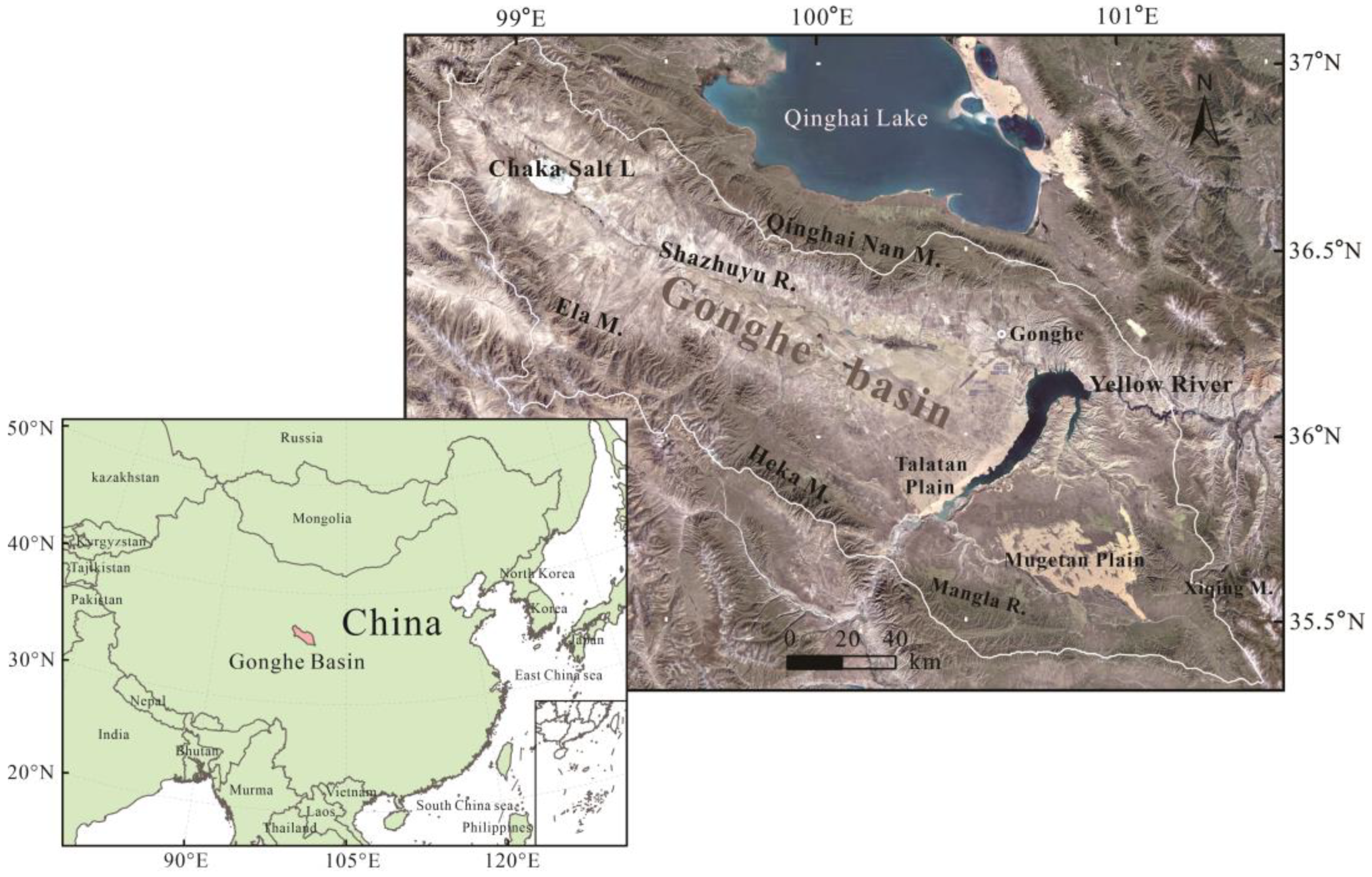
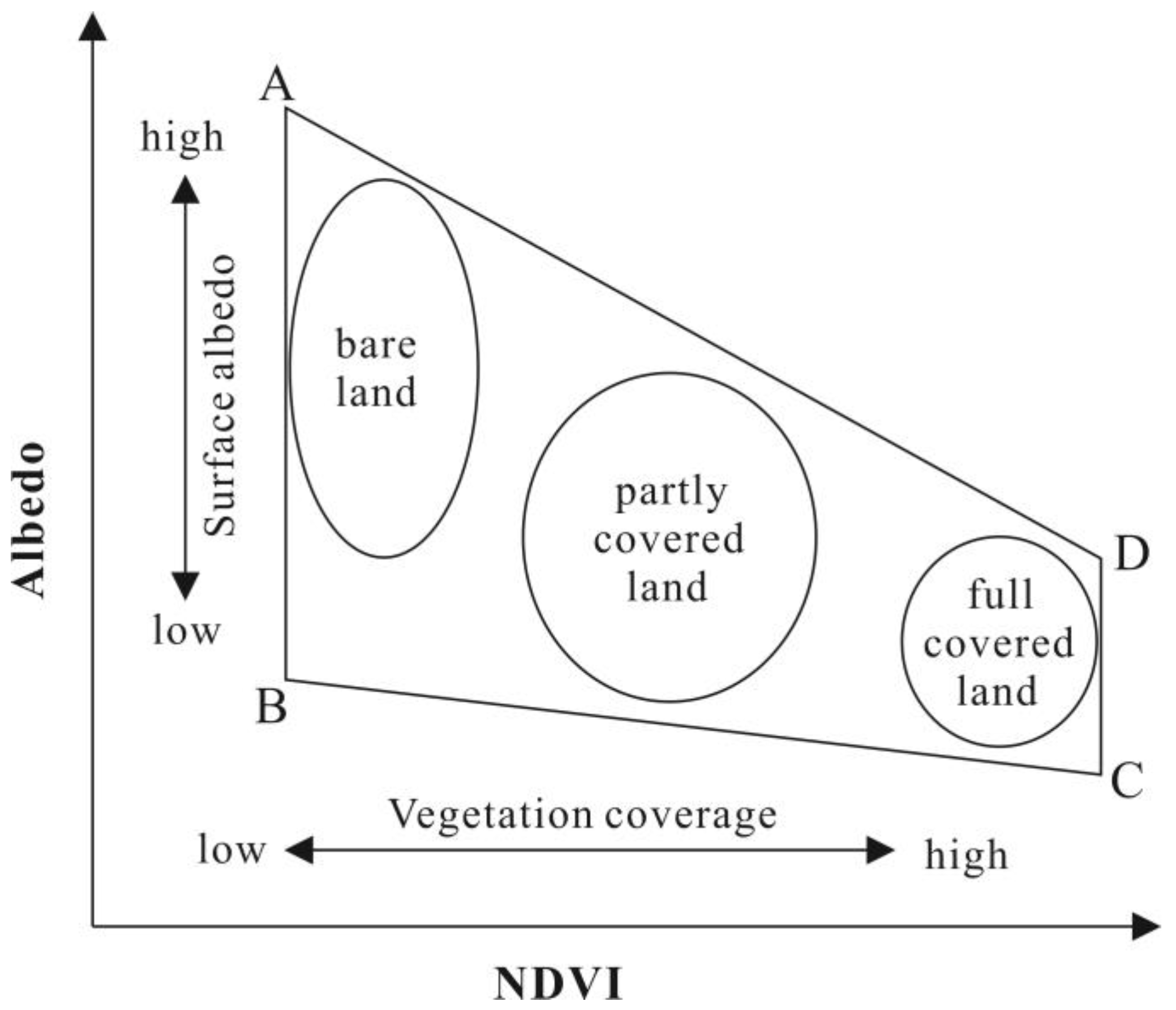
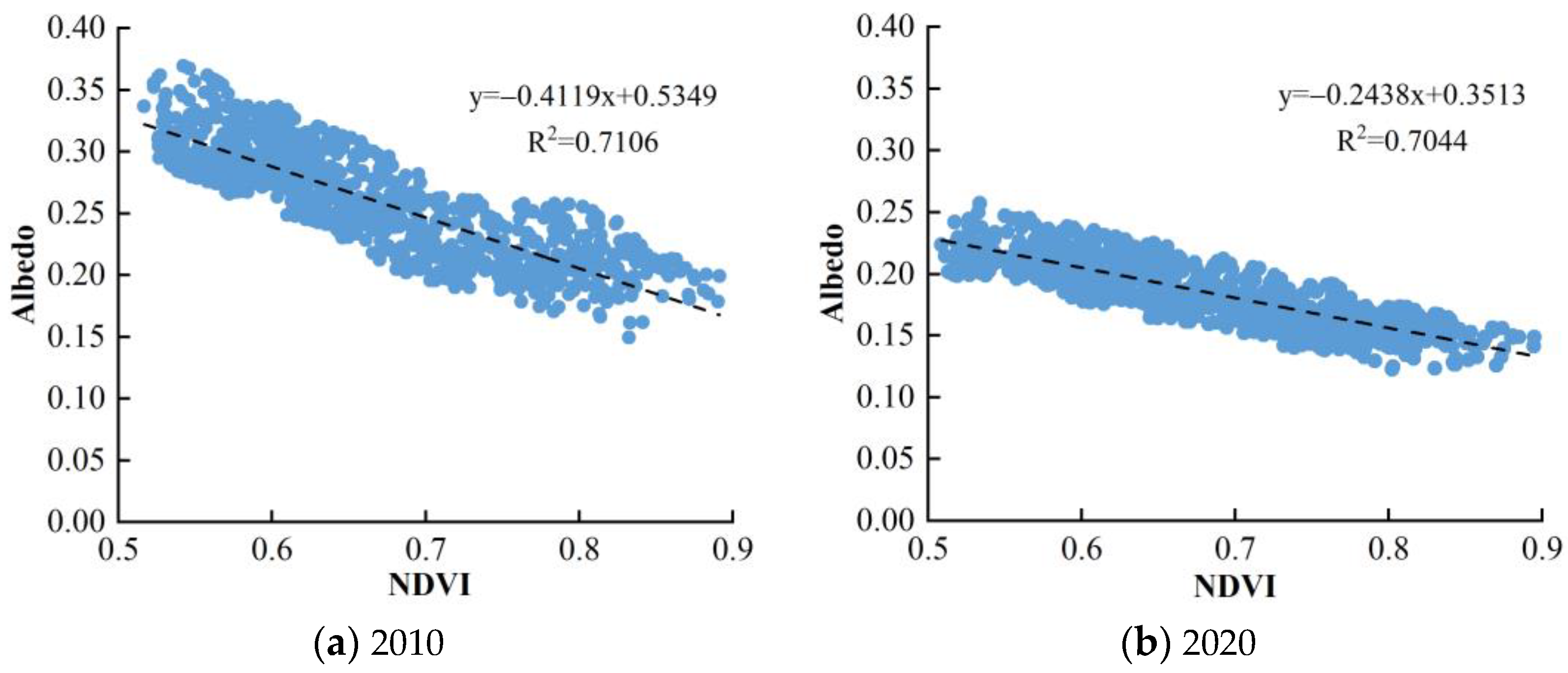
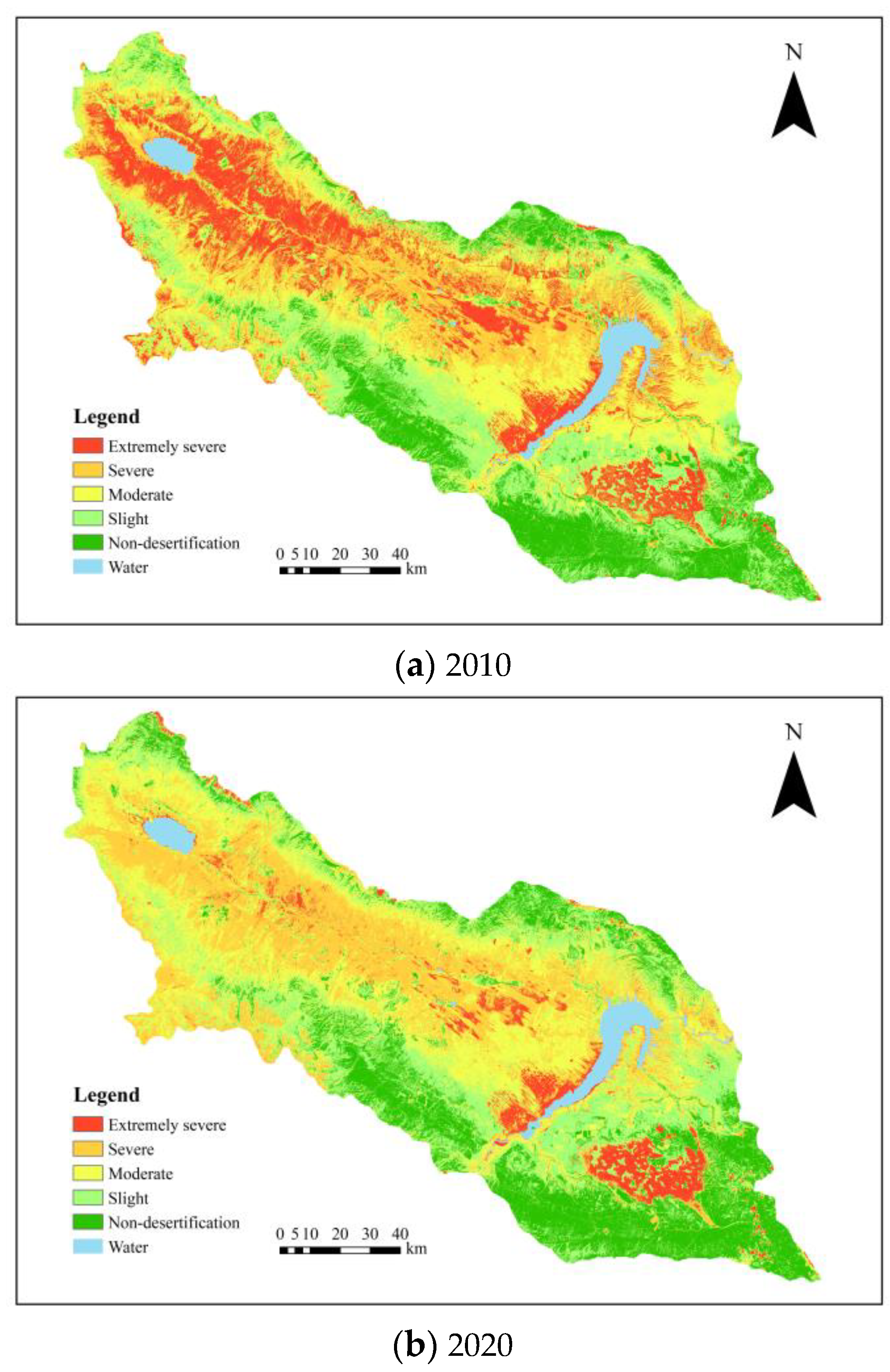
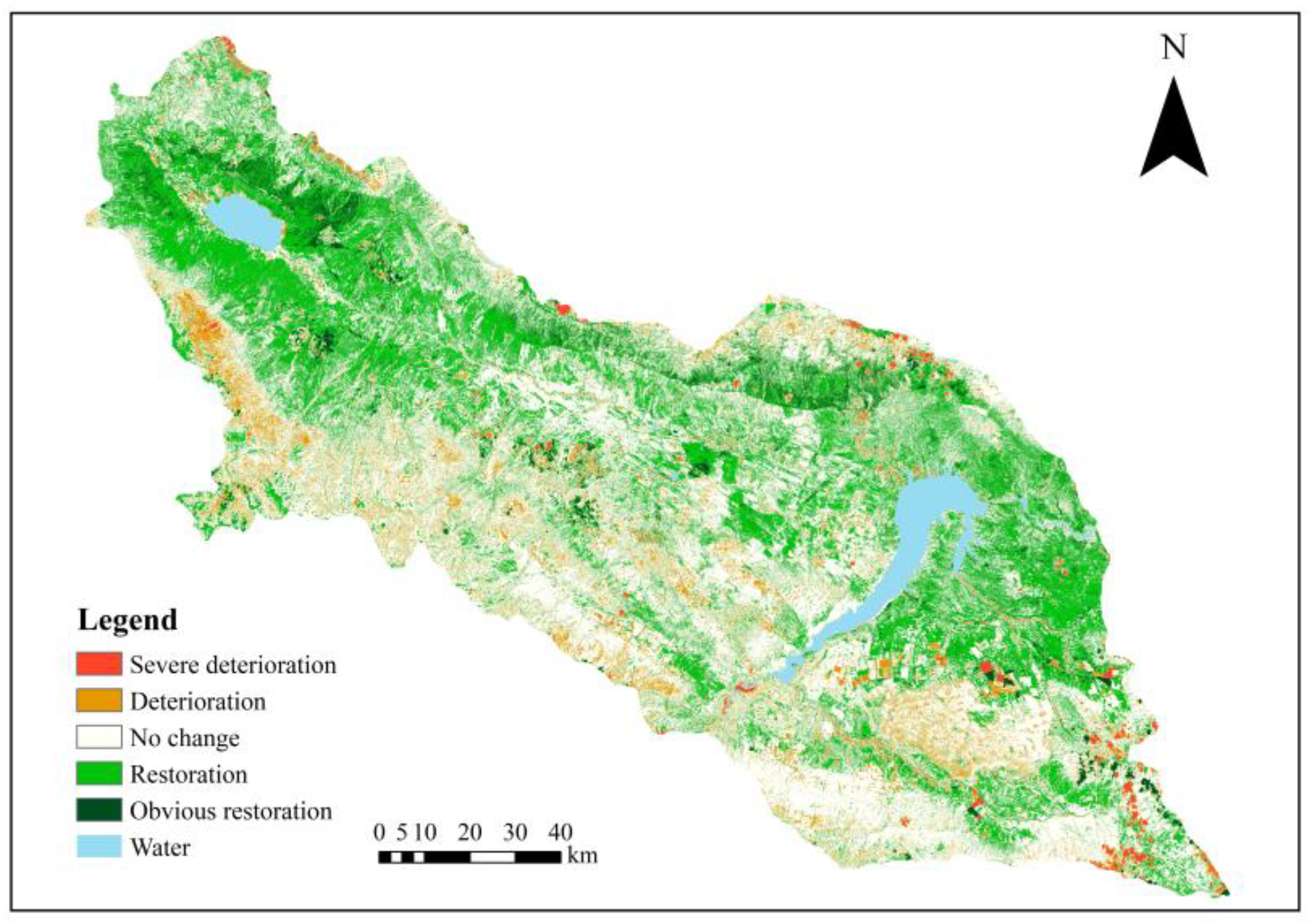

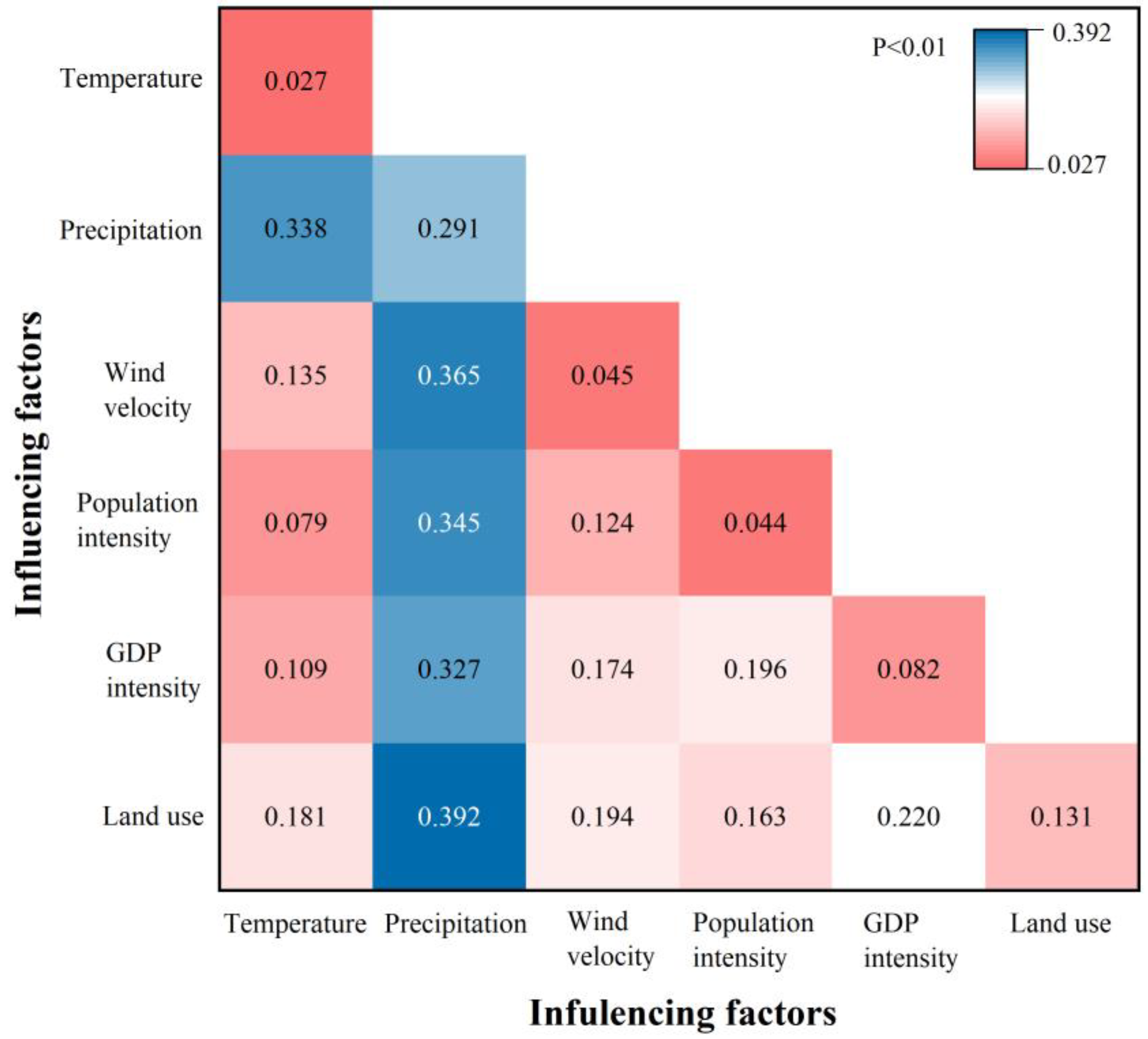
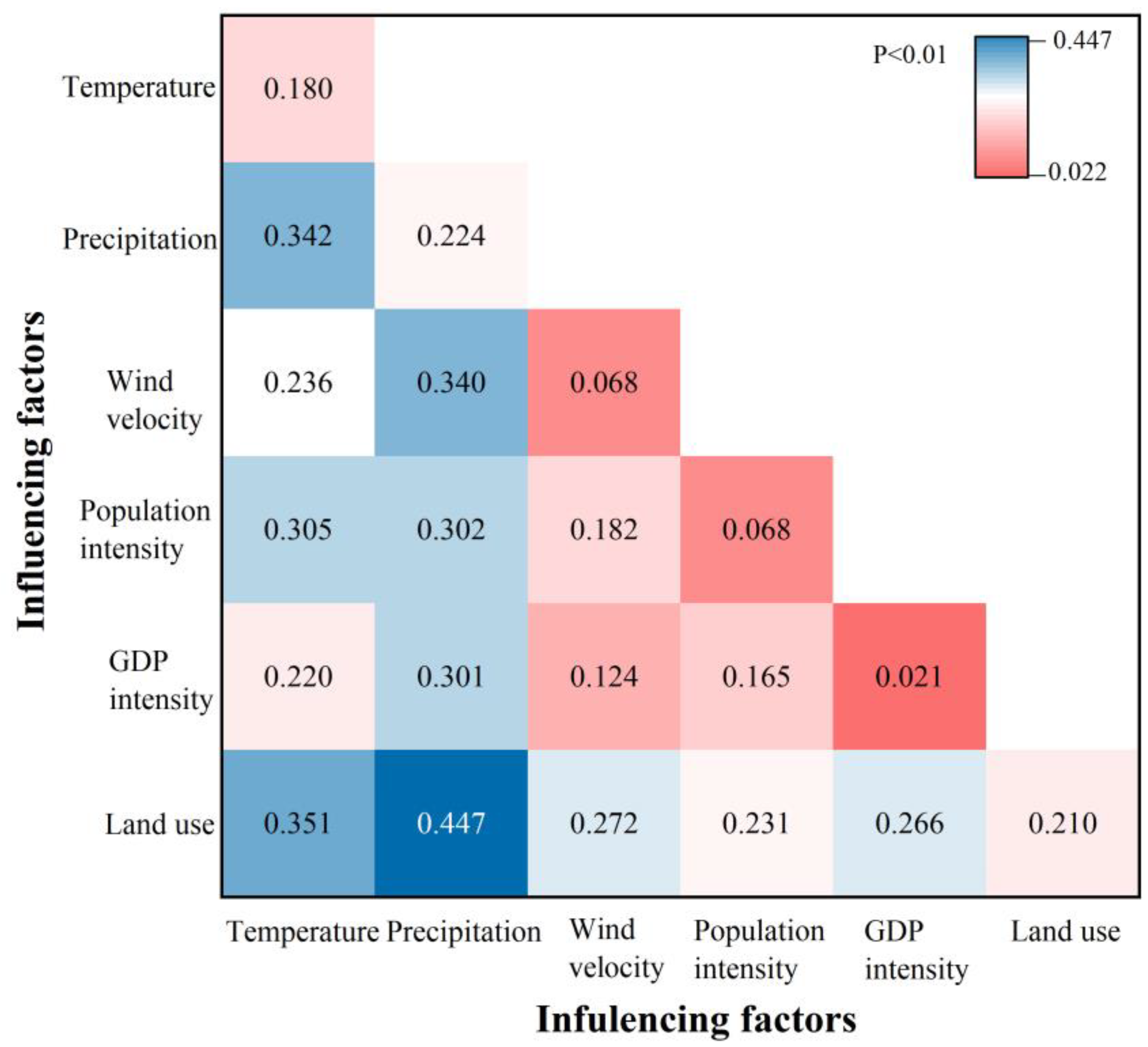

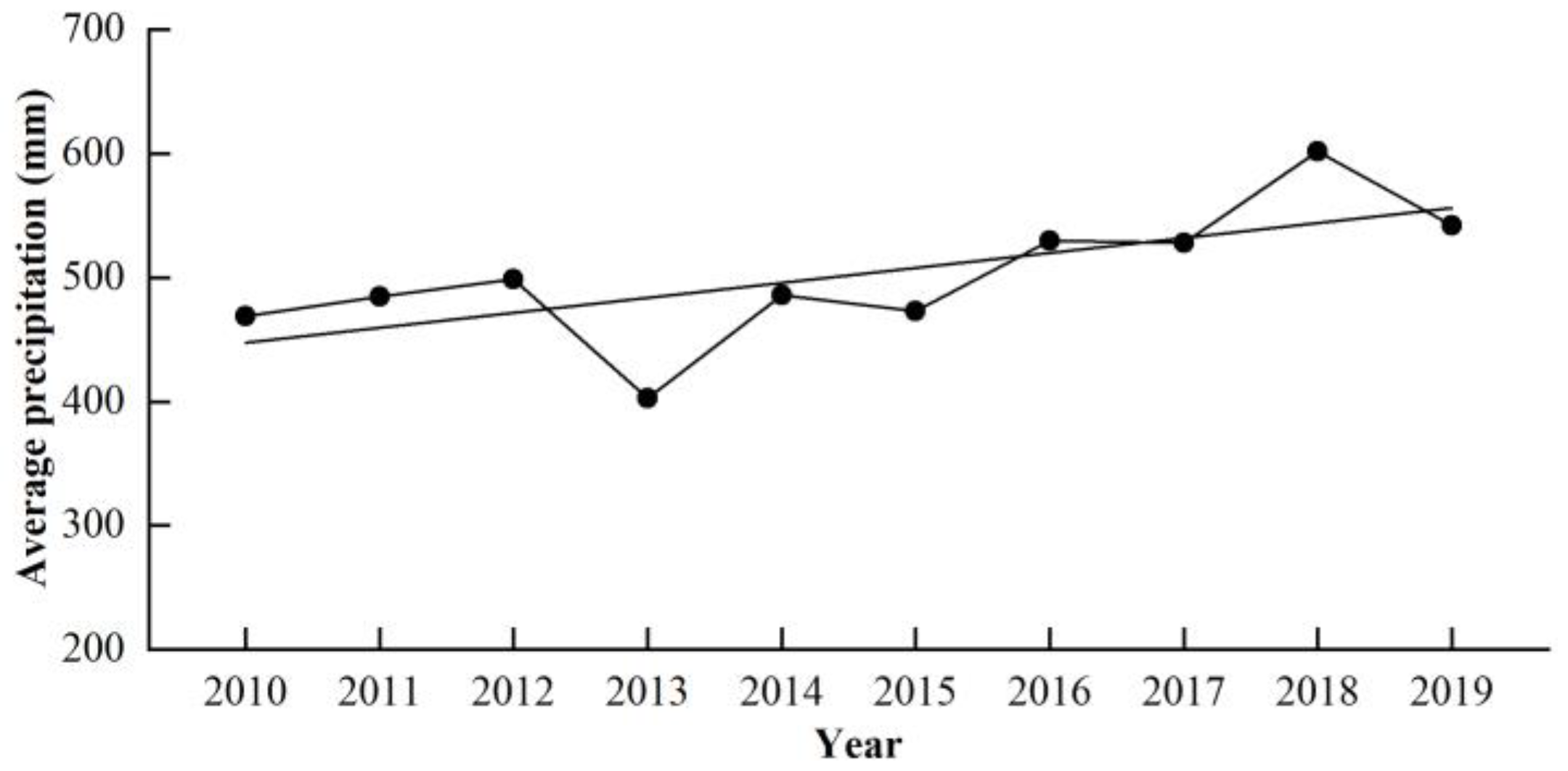
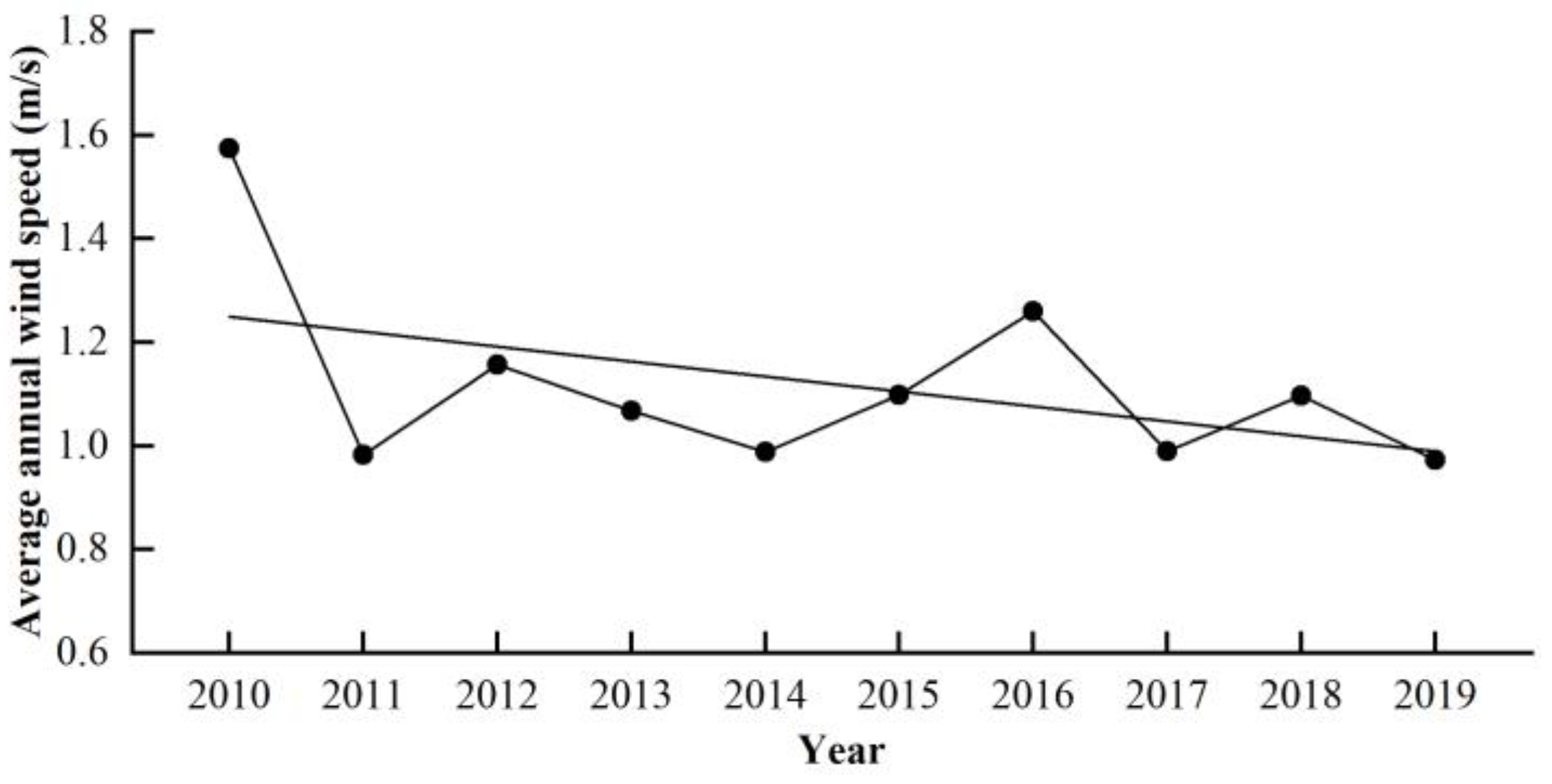
| Year | Linear Relationship |
|---|---|
| 2010 | DDI = 2.4278 × NDVI − Albedo |
| 2020 | DDI = 4.1017 × NDVI − Albedo |
| Year | Extremely Severe (%) | Severe (%) | Moderate (%) | Slight (%) | Non- Desertification (%) | Kappa Coefficient | OA (%) | |||||
|---|---|---|---|---|---|---|---|---|---|---|---|---|
| PA | UA | PA | UA | PA | UA | PA | UA | PA | UA | |||
| 2010 | 95 | 95 | 94.74 | 90 | 94.74 | 90 | 86.36 | 95 | 100 | 100 | 0.93 | 94 |
| 2020 | 95.24 | 100 | 95 | 95 | 94.74 | 90 | 90.48 | 95 | 100 | 95 | 0.94 | 95 |
| Category | 2010 | 2020 | 2010–2010 | ||
|---|---|---|---|---|---|
| Area (km2) | % | Area (km2) | % | Annual Rate of Change (%) | |
| Extremely severe | 3434.27 | 17.4 | 1098.95 | 5.6 | −6.8 |
| Severe | 4436.59 | 22.5 | 5028.72 | 25.5 | 1.3 |
| Moderate | 4595.28 | 23.3 | 5282.61 | 26.8 | 1.5 |
| Slight | 4153.31 | 21.1 | 4381.71 | 22.2 | 0.5 |
| Non-desertification | 3086.06 | 15.7 | 3913.52 | 19.9 | 2.7 |
| 2020 | Extremely Severe | Severe | Moderate | Slight | Non- Desertification | Total (Reduced) | |
|---|---|---|---|---|---|---|---|
| 2010 | |||||||
| Extremely severe | 827.92 | 2213.94 | 335.75 | 27.56 | 29.11 | 3434.27 | |
| Severe | 185.30 | 2402.03 | 1736.12 | 85.14 | 28.00 | 4436.59 | |
| Moderate | 35.58 | 355.75 | 2675.32 | 1418.13 | 110.51 | 4595.28 | |
| Slight | 25.53 | 35.19 | 484.33 | 2351.70 | 1256.56 | 4153.31 | |
| Non-desertification | 24.62 | 21.82 | 51.09 | 499.18 | 2489.35 | 3086.06 | |
| Total (increased) | 1098.95 | 5028.72 | 5282.61 | 4381.71 | 3913.52 | 19,705.51 | |
| 2010–2020 | Severe Deterioration | Deterioration | No Change | Restoration | Obvious Restoration |
|---|---|---|---|---|---|
| Area (km2) | 193.83 | 1524.56 | 10,746.31 | 6624.75 | 6160.63 |
| Percentage (%) | 0.8 | 6.0 | 42.6 | 26.2 | 24.4 |
Disclaimer/Publisher’s Note: The statements, opinions and data contained in all publications are solely those of the individual author(s) and contributor(s) and not of MDPI and/or the editor(s). MDPI and/or the editor(s) disclaim responsibility for any injury to people or property resulting from any ideas, methods, instructions or products referred to in the content. |
© 2023 by the authors. Licensee MDPI, Basel, Switzerland. This article is an open access article distributed under the terms and conditions of the Creative Commons Attribution (CC BY) license (https://creativecommons.org/licenses/by/4.0/).
Share and Cite
Jia, H.; Wang, R.; Li, H.; Diao, B.; Zheng, H.; Guo, L.; Liu, L.; Liu, J. The Changes of Desertification and Its Driving Factors in the Gonghe Basin of North China over the Past 10 Years. Land 2023, 12, 998. https://doi.org/10.3390/land12050998
Jia H, Wang R, Li H, Diao B, Zheng H, Guo L, Liu L, Liu J. The Changes of Desertification and Its Driving Factors in the Gonghe Basin of North China over the Past 10 Years. Land. 2023; 12(5):998. https://doi.org/10.3390/land12050998
Chicago/Turabian StyleJia, Hong, Rui Wang, Hang Li, Baijian Diao, Hao Zheng, Lanlan Guo, Lianyou Liu, and Jifu Liu. 2023. "The Changes of Desertification and Its Driving Factors in the Gonghe Basin of North China over the Past 10 Years" Land 12, no. 5: 998. https://doi.org/10.3390/land12050998






